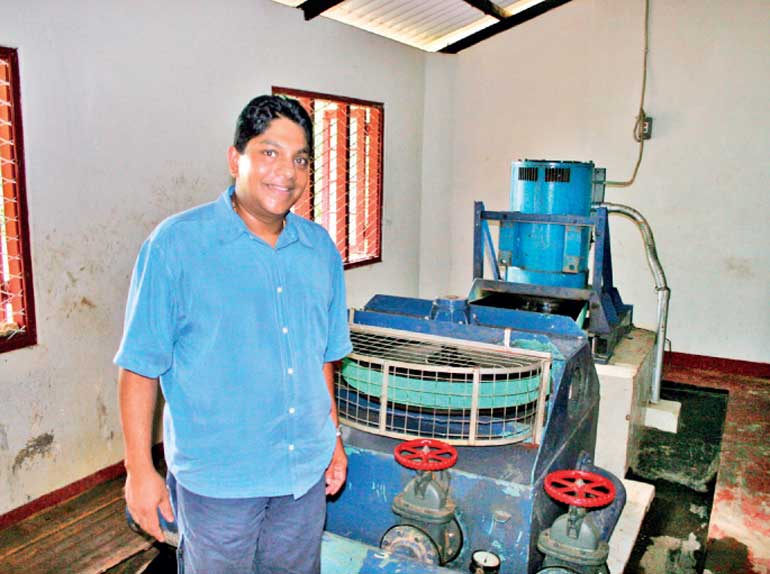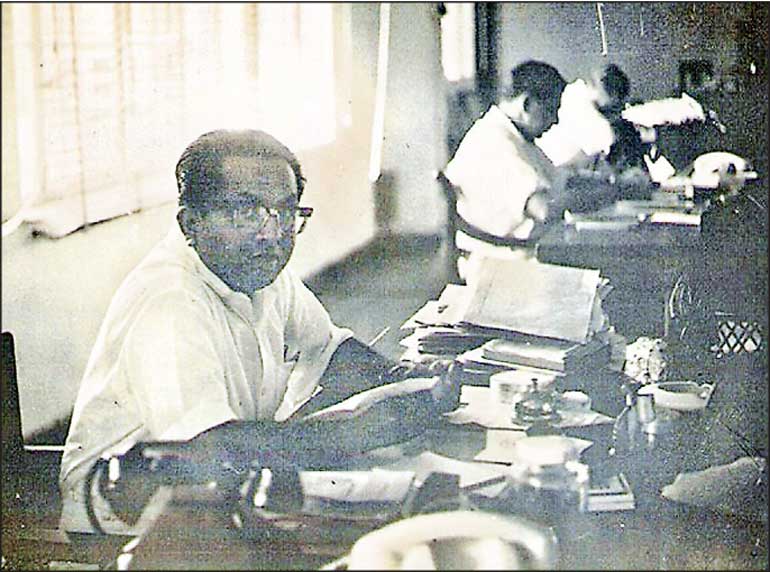Thursday Dec 11, 2025
Thursday Dec 11, 2025
Saturday, 27 August 2022 00:00 - - {{hitsCtrl.values.hits}}

Tissa Abeywickrama at Seethaeliya Hydro Power house in March 2006

Jayatissa Abeywickrama working at Bartleet in the 1970s
The objective of the Harmony page is to encourage harmonious wellbeing of humanity as well as the planet. We do this by promoting sustainability through self-sufficiency and creating awareness on nationally available resources that get side-lined or ignored from the macro economy discourse. In the past four years of pioneering a holistically integrated model of journalism that interlinks the spiritual with the material, we have created awareness on economic perspectives of promoting indigenous medicine, indigenous/heritage/traditional knowledge on food, non-poisonous farming and soil nurturing as well as practicalising spirituality and peace building.
Three months ago we started the renewable energy awareness campaign interviewing those who have worked towards promoting renewable energy in multiple ways, whether as independent engineers or those connected to the renewable energy divisions of Ceylon Electricity Board, development practitioners with international investor connections, Sri Lankan diaspora investors, or renewable energy entrepreneurs/innovators/inventors.
This week we feature a discussion with humanitarian activist and hydro energy practitioner, Tissa Abeywickrama who runs Seethaeliya; the mini hydro pioneered by his father Jayatissa Abeywickrama nearly four decades ago. Jayatissa Abeywickrama initiated the first Standard Power Purchase Agreement (SPPA) with CEB in 1995.
In this interview we look at the immense potential of private mini hydro power plants in Sri Lanka that could revolutionise small industries, especially the tea industry and enable private sale of excess energy generated through small businesses by tapping into diverse renewable options and thereby contributing to energy sustainability of the nation.
The second phase of this interview published later in this page with Tissa Abeywickrama will look at the humanitarian perspectives that encompass Sri Lanka’s current challenges and will draw on his vast experience with the Sri Lanka Red Cross (SLRC) as one of its youngest Presidents in the mid-1990s and later as its director general in 2009, having successfully chaired the Tsunami Task Force and heading post-conflict humanitarian assistance.
Below are excerpts of the interview focusing on the Seethaeliya mini hydro and the narratives around power generation through water resources of Sri Lanka and how this could lead to energy independence in this nation.
By Surya Vishwa
|
Jayatissa Abeywickrama at a young age
|
Q: Your father was a renowned pioneer of power generation through water resources of Sri Lanka. Please tell us his story.
My father, Jayatissa Abeywickrama was born in 1929, coming from a village called Morawaka in Matara district and was a student of Rahula College Matara. He worked in the tea industry as a tea grower and not as a planter per say. He was also a Tea Taster, Tea Marketer and Tea manufacturing adviser. Not only did he work in the tea industry, but he also passionately promoted and contributed to its development. He notably silently assisted small time tea industry aspirants.
In 1957 he joined as an executive at Bartleet & Co, and by 1964 at a relatively young age of 35 rose to be the director in charge of the tea sector. He had a deep love for nature and wanted to promote tea cultivation alongside promoting a pristine nature based setting. He wanted the tea estates to be energy sufficient in a nature friendly way. It is his connection with the tea industry that got him to look for renewable energy options based upon the natural resources of streams available in our estate premises in Deniyaya.
Sometimes after a drive inside an estate my father would show me, then a small child, a hydro power plant that generated electricity to power the factory. Sometimes we would walk near or inside the powerhouse, or we would stop where we could see it at a short distance. On all such occasions, he would tell me how these work; how a dola (stream) or river is dammed, water is brought through pipes and with a large wheel turned by the water and generator turned. He taught me at a very young age the importance and value of using water to generate electricity to power the factories and homes.
Q: How did the Seethaeliya tea factory based hydro power plant start?
In 1981, much after the times I described above, my father started the Seethaeliya Tea Factory in Kandipana, Deniyaya in Matara district on my father’s land. Kandilpana is a remote village even now. The road network in the area was in a dilapidated state from the time I can remember and was further dilapidated after a serious flood that happened in 2003. It was only repaired and carpeted around 2019.
When he started the factory, it was powered by a diesel engine electricity generator. There was no CEB power supply at the Kandipana village at the time. CEB power supply was available about 4 km away at the Enselwatta Tea Factory and although there was supposedly a State policy to support industrialisation and encourage more employment in rural Sri Lanka, my father’s queries to get CEB electricity to Seethaeliya Tea Factory and Kandilpana village on State account was only met by deaf ears.
Then in 1983 my father approached Brown & Co and met Andy Brown from UK, Lahiru Perera, P. Hettiarachchi and Pushparanjan, requesting them to design and develop a hydro power project to harness the water resource from Pandi dola that is flowing adjacent to our estate. After many deliberations the Seethaeliya hydro power project was completed and started providing electricity to our factory in 1984.
Q: Did the banks then support the funding of it?
No. Not at all. It is most likely the same story as now. I am told when my father searched to finance this project no banker was available to fund it as a project. He raised funds on a personal basis at a very high interest rate and on short-term loans, which would have been a heavy burden on his business cash flow. However, none seems to have deterred him from moving towards his inspiration.
In and around 1989 the factory was redeveloped, and its manufacturing capacity was doubled. This increased the demand for electricity too. I am told my father had to spend around Rs. 2 million to obtain CEB electricity supply to our factory.
The ridiculous aspect is that after him paying CEB for laying high tension power lines and installing a transformer at our factory premises, the authorities had drawn low tension power lines from this transformer at our factory premises to provide electricity to the Kandipana village within a short time of installing the power lines and transformer which my father had to pay for.
As hilarious as always, the authorities even had an opening ceremony with high level politicians present who would have given deaf ears to my father, when he made his requests to consider providing power supply from CEB to the Kandipana village and the tea factory in it. None of the authorities seems to have recognised over 500 direct and indirect employment opportunities the Seethaeliya Tea Factory brought to communities in the area.
Today several more villages in the area do receive CEB power drawn from this transformer and way back then my father overwhelmingly enjoyed the CEB distributing power to the villages from the transformer installed at our factory.
When our factory had CEB power installed my father envisioned that he would first use the electricity generated by the Seethaeliya hydro and draw only the remaining need from the CEB. Hence again he deliberated with Jerry Pope of GP Electronics of the UK and invested in importing and installing an automatically synchronising system (GP MainsCon System) to link both Seethaeliya hydro power and CEB supply together having the priority use power generated by Seethaeliya.
Q: Your father encouraged energy independence in Sri Lanka and was an example in selling excess hydro energy isn’t it?
Yes, he pioneered this. He realised that the power demand of a tea factory varies due to the nature of the tea manufacturing processes and he became interested in exporting/selling the excess electricity that the Seethaeliya hydro would be generating at times. Hence the task of deliberating with CEB to buy the excess power was initiated. After three years of intense deliberations resulted in us signing the first Standard Power Purchase Agreement (SPPA) with CEB in 1995. This opened opportunities for many private hydro power projects to be connected to the CEB. The potential for hydro power energy in Sri Lanka is vast and it is at least now the time for a national discourse on it.
Q: Could you highlight the capacity of power you started to generate and the reach as of now?
The capacity of Seethaeliya hydro is about 72 Kwh and it generates about this amount now.
Q: Who manages the Seethaeliya company/plant now?
The land in which the Seethaeliya Hydro Power and Seethaeliya Tea Factory is located, was owned by my father. He gifted them to me, my brother and sister, so we own and manage them now. I must state here that we follow the values instilled in us which may not match up to modern ways of showcasing businesses – we have no websites or publicity campaigns for our work. To us the practical impact we create is what matters. This type of thinking may not be common today and even be scoffed at but we learnt this from our father who had supported so many tea industrialists and a host of charities which we never knew he carried out until the persons concerned turned up at his funeral and told us.
Q: Do you have any idea what the collective hydro power capacity of all the streams and elas and dolas that we have in SL could be?
No, but it cannot be small.
Q: Fossil fuel is considered a curse caused by man to the earth he treads, upsetting and ruining the ecosystem and ecologists such as Ranil Senanayake have called it a satanic addiction where we are disembowelling the planet with. Your views?
Yes, of course fossil fuel has many green options that blend in with nature and does not hurt the earth. This was what we imbibed from my father. I will narrate an interesting story. Sometime ago when the authorities concerned came to examine the hydro plant for the necessary inspection protocol they upbraided us for ‘not having even a proper road towards the weir’ and where no one even will know that there were pipelines going through to facilitate the transfer from earth through water to energy. What we responded to the authorities was that this is exactly what we wanted – for nature to lie undisturbed by man, even as it facilitates the miracle of water becoming energy.
Actually, hydro energy can be accessed in a manner that is disrespectful to nature and in an abusive manner as seen in this age of modernity. But there were people of my father’s generation who were brought up with different values who were not yet brainwashed by making the earth our servant instead of respecting it as the master. We are today taught to value large initiatives but it is the small cloud that gathers in nature to provide all of humanity the rain we need.